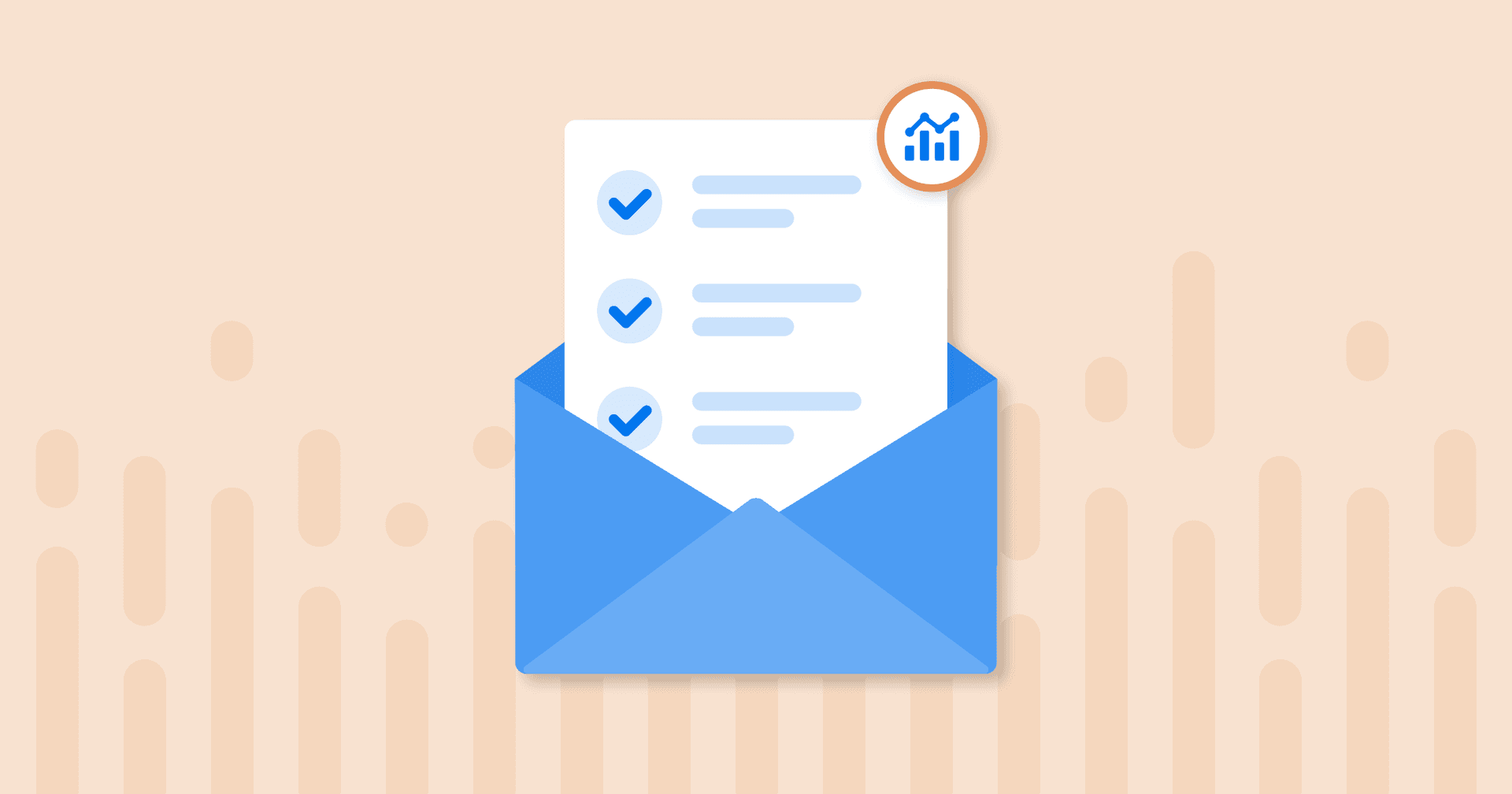
QUICK SUMMARY:
Customer retention KPIs measure the success of strategies in keeping clients engaged and loyal, directly influencing long term business growth and profitability. These metrics, including customer lifetime value and retention rates, highlight the balance between attracting new customers and nurturing existing ones. This article explores 28 KPIs to help marketing agencies boost client loyalty and build sustainable revenue streams.
Client loyalty is more important than you might realize. In the marketing world, most experts tend to focus on elements of client acquisition—the ability to attract new paying clients. But what happens to that new customer two months, or two years, down the line?
Yes, new customer acquisition is important, but you must consider the value breakdown of a new client versus a recurring one. But you can’t improve what you don’t measure, and that’s where customer retention KPIs come into play.
Why Client Retention is Key to Business Growth
It’s always fun to acquire a new customer–or 1,000 of them–for a client. Showing those successes in your monthly marketing reports is one of the great joys of working at a marketing agency.
However, successful businesses strive to strike a balance between attracting new customers and retaining existing ones, as both play a crucial role in ensuring business growth and profitability. It’s important that your agency understand and support both strategic areas of growth.
As a marketing agency, you know the importance of client retention. Let’s assume your client pays you an average of $1,000 a month; in this scenario, increasing the average length of time a client stays loyal will objectively increase the total value of every new client.
The same applies to your clients. The more customers you can keep coming back to your clients, the more revenue they generate, the higher customer acquisition costs can be while maintaining a solid ROI, and the happier the client will be with their bottom line results.
Here's a quick breakdown of the respective values of new vs. returning customers:
New Customers
Bring additional revenue and expand the customer base, which is vital for any growing business. They also provide new market insights and offer opportunities to diversify product or service offerings.
Every new customer is a potential brand ambassador who can share their positive experiences with their network, increasing your brand awareness. Plus, the touchpoints required to acquire new customers typically reach far and wide, well beyond the existing customer base.
New clients that are onboarded could be coming from the competition, which will increase market share and provide a competitive advantage.
Indicates the effectiveness of marketing strategies and campaigns.
However, acquiring a new client is often more expensive than retaining an existing one, which brings us to the value of recurring clients.
Recurring Customers
Research suggests that improving customer retention by just 5% can lead to an increase in profits of 25% to 95%. Recurring clients, on average, tend to spend more per transaction than new clients.
Investing in customer retention can significantly lower marketing costs. (It costs five to twenty-five times more to acquire a new customer than to retain an existing one.)
Are more likely to stay loyal to a brand, and loyal customers often leads to advocacy. They are more likely to refer a business to others, contributing to word-of-mouth marketing.
Recurring clients provide a more predictable and stable revenue stream, allowing better forecasting and budgeting.
Provide valuable feedback, enabling companies to improve products, services, and overall customer experience.
Both new and recurring clients have their own unique value, and successful businesses understand this and strive to build a model that effectively balances customer acquisition and retention strategies.
They invest wisely in marketing to attract new customers and simultaneously develop robust customer relationship programs to ensure client retention.
Increase Client Retention By Automating Your Client Reporting
Start Your Free 14-day TrialTailoring Customer Retention KPIs for Different Types of Clients
Each business type, from retail and service industries to e-commerce and B2B enterprises, has distinct characteristics and customer engagement patterns.
These unique features necessitate the crafting of specialized strategies and KPIs to enhance customer loyalty and retention.
In this section, we'll delve into how to tailor these client retention KPIs to fit the needs of different types of clients.
Customer Retention KPIs That Apply to Nearly Every Client
Some common KPIs will apply to nearly every business out there, so we’ve pulled them to the top of the list as they will be the ones your agency deals with most of the time.
1. Customer Retention Rate (CRR): The number of customers a retail business retains over a given period. A high Customer Retention Rate signifies high customer loyalty and satisfaction. Repeat Purchase Rate (RPR) is another common way to look at this data point.
2. Purchase Frequency (PF): This goes a step further and looks at how often a customer makes a purchase within a given time period. A higher purchase frequency typically indicates higher customer satisfaction and loyalty.
3. Customer Churn Rate: Although often considered a SaaS metric, this KPI applies to all businesses. It is the other side of the CRR coin, as it measures the percentage of customers that a business loses over a specific period. If the customer churn rate is high, it may suggest problems with the product, service, or customer support.
4. Customer Lifetime Value (CLV): Calculates the total revenue a business can reasonably expect from a single customer account. Customer Lifetime Value considers a customer's revenue value and compares that number to the company's predicted customer lifespan. Businesses use this metric to identify significant customer segments that are the most valuable to the company.
5. Average Repeat Order Value (AROV): Tracks the average dollar amount spent each time an existing customer places a new order. To calculate AROV, divide the total revenue by the number of orders from previous customers. This is typically much easier to do with an eCommerce business than in a brick-and-mortar setting where client data is not as readily available.
6. Average Revenue Per User (ARPU): The revenue generated per user or unit and provides insight into the value each customer brings to your business. Instead of measuring the average order value (AOV) for each individual purchase, this looks at how much an average customer is spending with the company during a set period of time.
7. Customer Satisfaction Score (CSAT): This is a straightforward indicator of how satisfied customers are with a product or service. Customer Satisfaction Score surveys can be used to gather this data, typically asking customers to rate their satisfaction on a scale of 1-5.
8. Net Promoter Score (NPS): Similar to a CSAT score, NPS measures customer loyalty by asking one simple question: "On a scale of 0-10, how likely are you to recommend our company to a friend or colleague?" The responses help businesses identify promoters (score 9-10), passives (score 7-8), and detractors (score 0-6).

Track all of your client’s key metrics automatically and create professional marketing reports and dashboards in minutes. Try AgencyAnalytics free for 14 days.
Specific Customer Retention KPIs for Local Retail Clients
Local retail businesses have specific needs and characteristics when it comes to client retention. Therefore, there are a couple of customer retention KPIs that a local retail business would have that would not–necessarily–apply to other types of business, so we’ve called them out separately.
9. Foot Traffic: Measures the number of people who enter your store. It helps local retail businesses understand their busiest hours and days, which can be used to optimize staffing, marketing efforts, and sales strategies. Although not strictly a retention KPI, client retention plays a huge role in keeping foot traffic high.
10. Customer Loyalty Program Participation: A key strategy for retaining clients. It measures the percentage of customers who participate in these programs.
Additional Customer Retention KPIs for eCommerce Clients
Retention KPIs for eCommerce businesses are often centered around user engagement, website metrics, and online customer behavior. Here are some client retention KPIs that are specific to eCommerce businesses:
11. Website Traffic Retention: A higher percentage often indicates that the site successfully engages customers and encourages them to come back.
12. Customer Email Open and Click-Through Rates: These KPIs measure how many existing customers open marketing emails (open rate) and how many click on the content within the email (click-through rate), providing insight into the effectiveness of the email marketing campaigns.
13. Wish List Conversion Rate: This is a valuable metric in e-commerce as it provides insights into customer preferences and intent.
Customer Retention KPIs Just for Software as a Service (SaaS) Clients
The KPIs used to measure client retention in a SaaS business often revolve around user engagement, subscription metrics, and product usage. Here are some customer retention KPIs that are specific to SaaS businesses:
14. Annual Recurring Revenue (ARR): The value of the recurring revenue of a business’s term subscriptions on an annual basis. It's a crucial KPI for SaaS companies as it shows the money that the company can expect based on current customers. Monthly Recurring Revenue (MRR) is a similar metric that looks at revenue at a monthly level.
15. Net Revenue Retention (NRR): The net amount of recurring revenue retained from existing customers in a given time period, including expansion revenue, contraction, and churn.
16. License Utilization Rate: For SaaS companies that charge per user, this KPI measures how many licenses are being used compared to the total number sold.
17. Active Users: This is the number of users who have logged in or used an application in a given time period. It can be measured daily, weekly, or monthly (DAU, WAU, MAU), depending on the nature of the SaaS product.
18. Feature Adoption Rate: The usage of individual features within the software. It helps marketers to understand what features are driving value for customers and can inform product development strategy.
19. Add-On or Feature Adoption and Cancellation Rate: The frequency at which customers add or remove features or add-ons to their subscriptions. High feature adoption rates often indicate that customers find value in these additional features, increasing stickiness. On the flip side, high cancellation rates may suggest that customers don't perceive enough value to justify the added cost or that they are decoupling themselves from the larger infrastructure.
Customer Retention KPIs Service-Based Clients Care About
Service-based businesses, whether they offer professional services, hospitality, or any other type of service, have unique customer retention KPIs that go above and beyond the ones listed at the top of this section. These specific KPIs revolve around customer satisfaction, quality of service, and customer loyalty.
20. First Response Time: The average amount of time it takes for a customer to receive an initial response to their query or complaint. A lower first response time can lead to higher customer satisfaction.
21. Resolution Time: The average time taken to resolve customer issues or complaints. A shorter resolution time often leads to higher customer satisfaction.
22. Cross-Selling and Upselling Rates: Measure the success of efforts to sell additional, complementary, or higher-tier services to existing customers. High rates can indicate strong customer relationships and satisfaction.
23. Renewal Rate: For service-based businesses that rely on contracts or subscriptions, this KPI measures the percentage of customers that choose to renew their agreement. A higher rate signifies better customer retention.
Customer Retention KPIs for Marketing Agencies
And, of course, it’s important to think about your own client loyalty. Yes, trust, transparency, and campaign performance are keys to customer retention, but how will you know if you’re on track for all of those things if you aren’t taking a moment to measure them?
24. Average Client Lifespan: Measures the average length of time clients stay with your agency. The longer the lifespan, the better your agency is at retaining clients.According to our recent Marketing Agency Benchmarks Survey, 70% of the marketing agencies that use the AgencyAnalytics platform for their client reporting have an average client lifespan of 2+ years.

25. Client Communication Response Time: How long it takes your agency to respond to client communications. Quick response times can lead to better client relationships and retention. Nearly 37% of marketing agencies surveyed listed “Effective Communication” as the key to client retention.
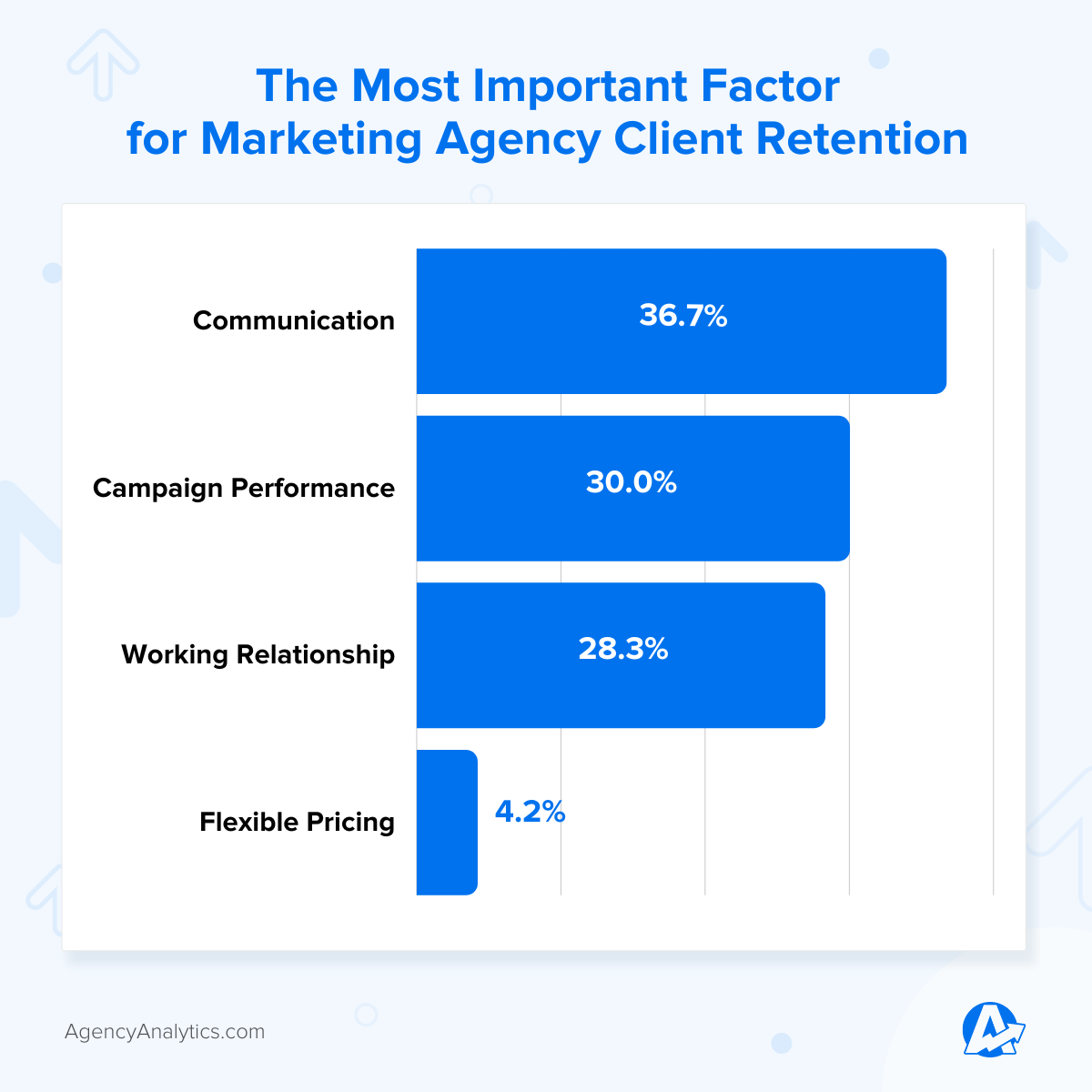
26. Marketing Report Open Rate: The percentage of clients who open and engage with the reports and updates you send them about the marketing strategies you're implementing for their business. High open rates can indicate that clients are actively engaged with your agency's work, find value in the reports, and are likely to remain with your agency.
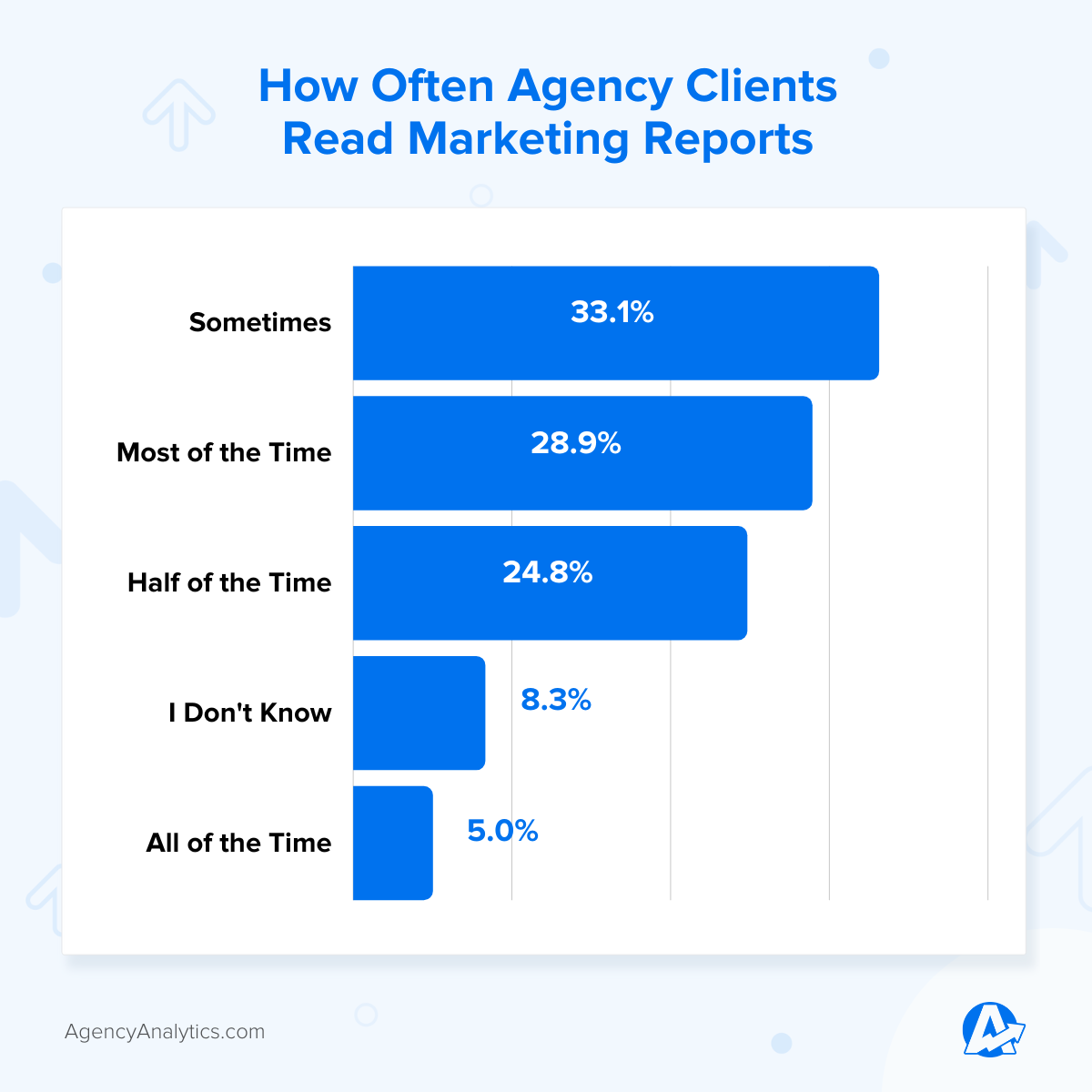
27. Project Completion Rate: How many projects are completed on time and within budget. A higher rate indicates efficiency and reliability, which can enhance client retention.
28. Cross-Selling and Upselling Rates: Often connected to Account Expansion Rate, these KPIs measure the success of efforts to sell additional, complementary, or higher-tier services to existing clients. High rates can indicate strong client relationships and satisfaction.
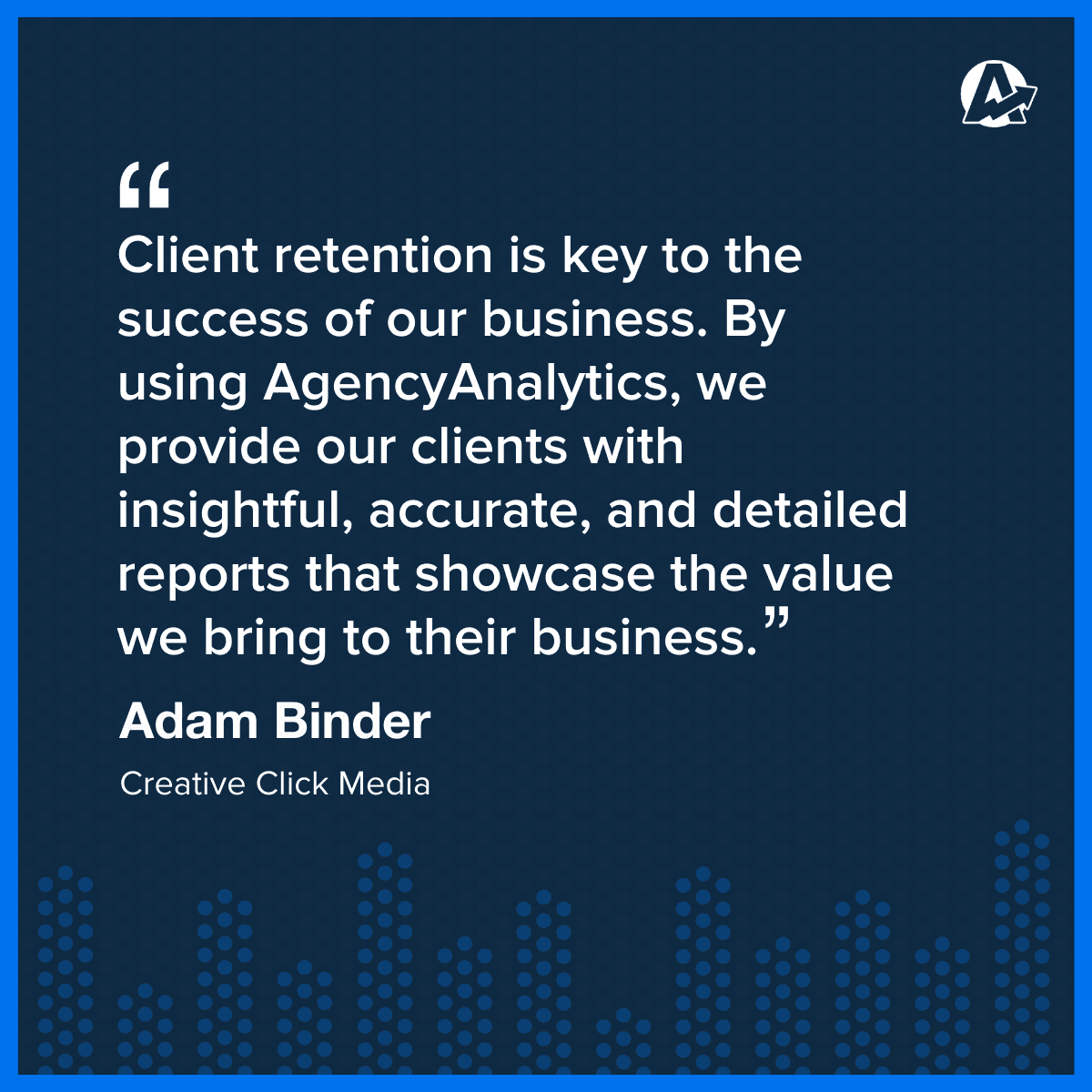
Report Smarter, Not Harder.
Start Your Free Trial TodayHow To Implement Customer Retention KPIs as Part of the Marketing Strategy
Implementing retention KPIs as part of your client’s marketing strategy requires a systematic and thoughtful approach. The right KPIs can provide valuable insights, leading to data-driven decisions that improve marketing performance. Here's a step-by-step guide on how you can implement customer retention KPIs in your marketing strategy:
1. Identify Key Business Goals
Start by clearly defining your business objectives. This might be to improve client satisfaction, increase loyalty, reduce churn rate, or boost revenue. The business objectives will guide the selection of the appropriate KPIs to track.
2. Select Relevant KPIs
Choose KPIs that align with your business objectives and are relevant to your specific industry or business type. The KPIs should offer insights that can help you achieve your goals. Be careful not to select too many KPIs, as this can lead to an overwhelming amount of data and a lack of focus.
3. Set Benchmarks and Targets
Determine what success looks like for each KPI. This could be industry standards, past performance, or specific targets that you aim to achieve. This will provide a standard against which you can measure your progress.
4. Collect Data
Establish processes for consistently collecting data for each KPI. This might involve using CRM software, analytics tools, customer surveys, or other data collection methods. Ensure that the data collection process is reliable and accurate.
5. Analyze and Interpret Data
Regularly analyze the data you collect and interpret what it means in the context of your business objectives. Look for trends, patterns, and insights that can inform your strategy.
6. Make Informed Decisions
Use the insights gained from the KPIs to inform your marketing decisions. This might involve making changes to your marketing strategies, enhancing customer service response time, improving product offerings, or developing new initiatives to improve client retention.
7. Review and Adjust KPIs
Periodically review your KPIs to ensure they remain relevant and effective. As your business and the market environment evolve, you may need to adjust or change your KPIs.
8. Communicate KPIs and Insights
Share KPIs and insights with relevant team members. This encourages a data-driven culture, ensures everyone understands the business objectives, and enables the team to contribute ideas for improvement.
Remember, the aim of implementing customer retention KPIs is to improve your client’s marketing strategy and grow their business. It's an ongoing process of measurement, analysis, and adjustment to continually enhance client retention and satisfaction.
Read More: What’s the Difference Between OKRs and KPIs?
Pitfalls To Avoid When Measuring Client Retention KPIs
While measuring client retention KPIs provide valuable insights and improve marketing strategies, there are several potential pitfalls that can lead to inaccurate data, misconceptions, and missed opportunities. Here are some common pitfalls to avoid when measuring customer retention metrics and KPIs:
Mistake #1. Ignoring Client Feedback
The focus on numerical KPIs can sometimes overshadow the qualitative feedback provided by clients. Always value direct client feedback and use it to inform the KPIs and overall strategy.
Mistake #2. Relying on a Single KPI
While certain KPIs may seem especially important, relying on a single metric to understand client retention can give you a skewed picture. Each KPI provides a unique perspective, and they should be used in conjunction to get a comprehensive understanding.
Mistake #3. Overcomplicating KPIs
That being said, while it's important to track relevant metrics, trying to measure too many KPIs can lead to analysis paralysis. Focus on a select few that align closely with the business goals.
Mistake #4. Neglecting Industry Standards
When setting benchmarks and targets, it’s crucial not to neglect industry standards. Comparing KPIs with industry standards gives you a better idea of your competitive standing.
Mistake #5. Not Reviewing KPIs Regularly
The market and the business are constantly evolving, so your KPIs should too. Regularly review and adjust the KPIs to ensure they are still relevant and provide valuable insights.
Mistake #6. Overlooking the Importance of Data Accuracy
Ensure the data you're collecting for the KPIs is accurate. Misinterpreted or incorrect data can lead to wrong decisions.
Mistake #7. Neglecting Actionable KPIs
The purpose of tracking KPIs is to inform actions. If a KPI isn’t helping you make decisions and improve your strategy, you may want to reconsider its relevance. Using Vanity Metrics as KPIs might look good on paper but don’t actually impact your business goals or offer actionable insights.
Mistake #8. Not Aligning KPIs with Business Goals
Always align your KPIs with the overall business objectives. KPIs that don't correlate with the goals can lead you to misallocate resources and miss out on key insights.
Mistake #9. Confusing KPIs with Metrics
KPIs and metrics are not the same, even though they're often used interchangeably. A metric is a quantifiable measure that can track and assess the status of a specific process, while a KPI is a metric that is tied directly to a strategic business objective. While all KPIs are metrics, not all metrics are KPIs. Be sure to identify which metrics are crucial to achieving your business objectives and designate those as your KPIs.
By being aware of these pitfalls, you ensure that your measurement of customer retention metrics and KPIs is as effective and informative as possible, leading to meaningful improvements in your marketing strategy and client retention efforts.
We have improved workload efficiency, lowered business costs, and improved client retention rate - everything our business looks to achieve.


Create Beautiful White Labeled Reports that Put Your Brand Behind Your Clients’ Success
Start Your Free 14-day TrialQuick Tips for Improving Client Loyalty–for Yourself, and Your Clients
Today, just about every marketplace is flooded with competition, and because users can do research and switch easily, brand loyalty isn’t as common or as easy to attain as it used to be.
Still, there are five surefire ways to cement loyalty in your own customer base and those of your clients:
1. Objective Value
Despite the “warm fuzzies” or other emotional connections a modern consumer might feel toward a brand, the vast majority of consumer decisions are still dictated by pure logic. They’re paying money for a certain product or service, and they expect a certain value from that exchange.
If you can consistently offer them a better value than anyone else, there’s no reason for them to ever leave this brand.
This path is a little ambiguous because it doesn’t necessitate you to have any real relationship with your consumer. They might not even recognize your brand out of a lineup—but as long as you’re there, giving your clients exactly what they need for a better price than anyone else, you’ll be at the top of their list.
But keep in mind that all of the competitors will be striving for the same advantage.
2. Differentiation
The above path implies a kind of apples-to-apples comparison between two companies. If both are offering apples, the competitor who can offer the biggest, tastiest apple for the lowest price and the best service will usually win the loyalty of clients indefinitely.
But this path, differentiation, takes a tangential approach, creating an organic apple that is raised without pesticides or a neon pink that can appeal to a specific demographic. Or, leave apples behind completely and pick oranges instead.
The goal here is to offer something unique, that nobody else can offer. For example, you might offer a turnkey suite of SEO audit services as a collective package that no other firm offers in such a bundle.
Or you might have an integration that no other software on the market currently supports, such as how AgencyAnalytics integrates automatically with GoogleAnalytics 4, unlike a certain, avian-themed reporting platform.
Obviously, this differentiating factor must be inherently valuable, but it can’t be directly compared to a competitor, and it’s rare—and those two things are what will allow it to secure further client loyalty.
3. Loyalty Rewards
This is definitely the most “obvious” item on this list (since it has the word “loyalty” already in its description). However, there’s much room for creativity here.
Loyalty rewards are any kind of valuable addition to your ordinary products and services that keep people coming back for more. For example, you might give your clients escalating discounts based on how long they remain committed to your brand, or you might have some kind of “check in” bonus every time a client visits you or logs into your app.
The benefit here is clear; clients are motivated to stay with you to continue receiving these rewards (as long as the rewards themselves are valuable enough). This is even more powerful if the rewards escalate in a kind of chain—a repeated pattern of habits, which, as Jerry Seinfeld reminds us, is very difficult to break once created.
4. Personal Experience
Even though your company might be managing dozens, hundreds, or thousands of clients, each client is an individual and deserves individual attention. It might seem strange to go out of your way to make one specific client’s experience special when you have so many other clients to manage, but trust me—that client will remember the experience.
If you’ve ever experienced the other side of this, you should know, intuitively, why it works. Going out of your way to make a client happy shows incredible commitment and will cement your brand reputation in that person’s brain. Don’t be afraid to go the extra mile, even if it’s extra work. It’s worth it to secure that individual’s loyalty forever.
Although creating report templates helps to streamline the client onboarding process, it’s worth taking a moment to consider which report customizations and widgets will make sense for an individual client. This kind of information can be gleaned during the client discovery meeting, and then implemented as part of your agency’s reporting processes to make sure the client is receiving exactly what they need.
5. Growth and Development
Things never stay the same for long, and clients know this. A handful of business models, like a mom-and-pop diner, might actually draw power from never changing, but for the rest of us, growth and change are good things. When new technologies such as AI tools emerge or a recession looms in the future, you need to figure out if, when, and how to adjust. When client trends change, you need to shift.
Regularly introducing new features, new values, and new benefits to your clients keeps the novelty factor strong and shows that you’re committed enough to your clients to initiate and manage real growth. This shows that you’re worthy as a long-term partner and will keep people around for the long haul.
You aren’t limited to only these five paths of client loyalty, but they are the most powerful strategies I’ve found (for the vast majority of businesses). Similarly, don’t feel limited to using only one of them; in fact, these strategies complement and enhance each other, so it’s in your best interest to use several of them simultaneously. As always, your biggest tool to success here is feedback; pay attention to what your clients do and don’t like, and correct your approach accordingly over time.
Receive Agency Growth Tips, Delivered to Your Inbox
Summary and Key Takeaways
The importance of client retention in any business, particularly in marketing agencies, cannot be overstated. Retaining clients is not just cost-effective; it typically leads to greater profits, increased customer loyalty, and a stronger reputation for a business. Key Performance Indicators are instrumental in tracking and improving client retention, providing valuable insights and data to inform the marketing strategy.
However, ensuring data accuracy and aligning KPIs with business goals is also crucial.
This is where AgencyAnalytics comes into play: a comprehensive, easy-to-use platform designed to help marketing agencies measure and report all of their clients' marketing KPIs quickly and effectively.
There's trust that comes with the agency/client relationship when you offer complete transparency instead of just a white sheet once a month with some numbers on it.
Brooke Lamberti, Director of SEO, RiZen Metrics
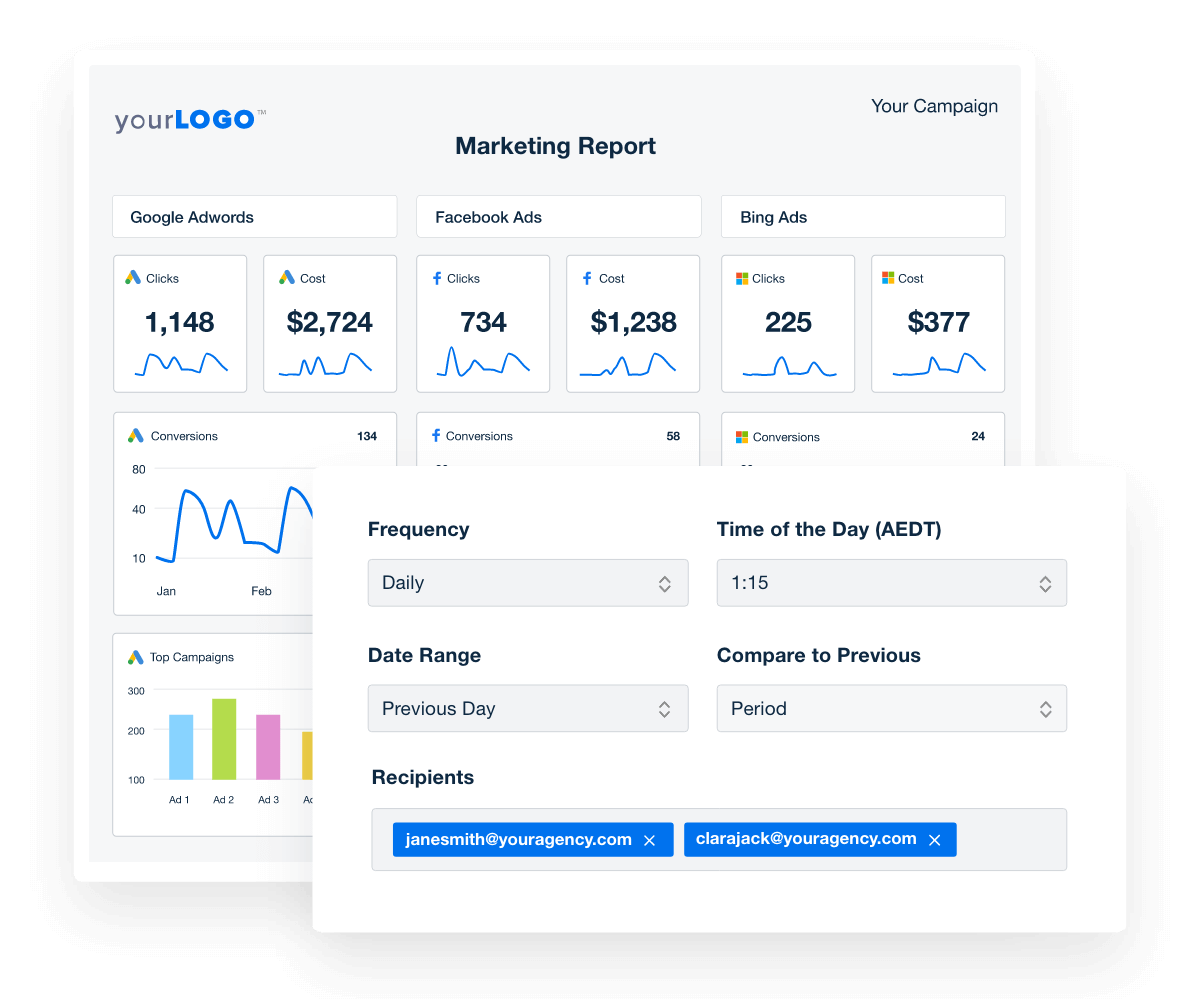
Make your client retention efforts more targeted, data-driven, and successful. Try AgencyAnalytics free for 14 days and see why over 6,500 agencies use it.

Written by
Paul Stainton is a digital marketing leader with extensive experience creating brand value through digital transformation, eCommerce strategies, brand strategy, and go-to-market execution.
Read more posts by Paul Stainton ›Get Started for Free



